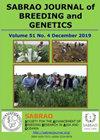香根草(香根草)耐盐生态型评价
IF 1.7
Q3 PLANT SCIENCES
引用次数: 0
摘要
香根草是一种精油植物,俗称香根草油。凭借深、宽、粗的根系,该物种能够很好地适应各种环境压力,包括盐度。本研究通过对不同盐胁迫条件下香根草生态型的评价,确定了具有较强耐盐性的香根草生态型。该研究继续采用完全随机设计(CRD),采用因子安排和两因素。第一个因素是盐度胁迫,包括6个不同的水平,即对照(无盐度)和4、8、12、16和20 dsm-1的盐碱地。第二个因子包括三个香根草生态型:Bogor、Bojonegoro和Padang。结果表明,盐胁迫水平、生态型及其相互作用显著影响了油菜的生长、生理和产量性状,如株高、叶面积、分蘖数、叶绿素a和b、根长和根体积以及产量。盐胁迫显著影响植株生长,但提高了叶绿素a和b含量。生态型博永尼哥罗的冠层生长较好,而生态型巴东的根系生长较好,产量高于生态型博永尼哥罗。16 dsm-1盐胁迫生态型Bojonegoro显著提高了叶绿素a和b含量,与盐胁迫条件相比,无盐胁迫生态型巴东的产油量最高。本文章由计算机程序翻译,如有差异,请以英文原文为准。
VETIVER (VETIVERIA ZIZANIOIDES L.) ECOTYPES ASSESSMENT FOR SALINITY TOLERANCE
Vetiver is one of the essential oil-producing plants, commonly called vetiver oil. With a deep, broad, and thick root system, the species is characteristically well-adapted to various environmental stresses, including salinity. The presented study strived to evaluate several vetiver ecotypes under diverse salinity stress conditions and identify the best with enhanced salinity tolerance. The said study continued in a completely randomized design (CRD) with factorial arrangement and two factors. The first factor was salinity stress comprising six varying levels, i.e., control (without salinity) and saline soils with 4, 8, 12, 16, and 20 dsm-1. The second factor consisted of three vetiver ecotypes: Bogor, Bojonegoro, and Padang. The results revealed that salinity stress levels, ecotypes, and their interactions significantly affected the growth, physiological, and oil yield traits, such as plant height, leaf area, number of tillers, chlorophyll a and b, root length and volume, and oil yield. Salinity stress at 16 dsm-1 significantly impacted plant growth but enhanced chlorophyll a and b content. The ecotype Bojonegoro had better canopy growth, while the ecotype Padang had better root growth, resulting in higher oil production compared with the ecotype Bojonegoro. The ecotype Bojonegoro with 16 dsm-1 salinity stress significantly increased chlorophyll a and b content, and the ecotype Padang showed the highest oil production without salinity stress compared with salinity stress conditions.
求助全文
通过发布文献求助,成功后即可免费获取论文全文。
去求助
来源期刊

Sabrao Journal of Breeding and Genetics
农林科学-奶制品与动物科学
CiteScore
1.90
自引率
50.00%
发文量
63
期刊介绍:
The SABRAO Journal of Breeding and Genetics is an international journal of plant breeding and genetics research and was first published in 1969. It is the official publication of the Society for the Advancement of Breeding Research in Asia and Oceania (SABRAO).
Its objectives are to: promote the international exchange of research information on plant breeding and genetics, by describing new research findings, or ideas of a basic or practical nature; and be a medium for the exchange of ideas and news regarding members of the Society.
The Journal gives priority to articles that are of direct relevance to plant breeders and with emphasis on the Asian region. Invited for publication are research articles, short communications, methods, reviews, commentaries, and opinion articles. Scientific contributions are refereed and edited to international standards.
The journal publishes articles for SABRAO members mainly. The Journal preferred strongly that at least one author should be a current member of the Society. Non-members may also publish in the journal.
 求助内容:
求助内容: 应助结果提醒方式:
应助结果提醒方式:


